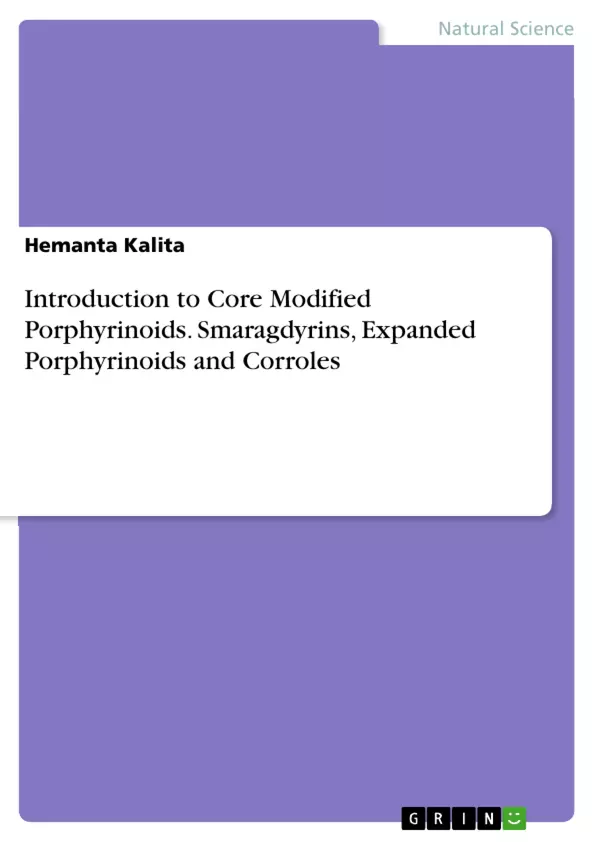This work gives an overview over core modified Porphyrinoids. Specifically: Smaragdyrins, Expanded Porphyrinoids and Corroles. It does so by, in two chapters, defining each of the aforementioned chemical combinations´ synthesis and characterization, properties and respective dyads.
Smaragdyrin is a pentapyrrolic 22π-electron expanded porphyrin system bearing two direct pyrrole-pyrrole bonds. This macrocycle and its core modified derivative i.e. 25-oxasmaragdyrin have received upsurge interest in recent years due to their notable optical and electrochemical properties. Corroles are aromatic tetrapyrrolic macrocycles containing one meso carbon less compared to porphyrins and have one direct pyrrole-pyrrole linkage. This class of macrocycle possesses novel spectral, electrochemical and luminescence properties that can be exploited in material applications. In this book, we have discussed the synthesis, properties and their limited coordination chemistry of expanded porphyrinoid 25-oxasmaragdyrin and core-modified corroles.
Corroles, on the other hand, are tetrapyrrolic contracted porphyrins, fully conjugated 18π electron macrocyles containing three methine bridges and one direct pyrrole-pyrrole linkage.
Inhaltsverzeichnis (Table of Contents)
- Chapter I: Smaragdyrins and Expanded porphyrinoids
- 1.1 Introduction
- 1.2 Smaragdyrin
- 1.3 Synthesis and characterization
- 1.4 Metal and Non-metal Complexes of Smaragdyrin
- 1.5 Properties of Smaragdyrin
- 1.6 Smaragdyrin Based Dyads and Triad
- 1.7 Phosphorus Complexes of Corroles and Expanded Macrocycles
- Chapter II: Core-modified Corroles
- 2.1 Introduction
- 2.2 Synthesis of Core-modified corrole
- 2.3 Spectral Properties of Corroles
- 2.4 Corrole Based Dyads
Zielsetzung und Themenschwerpunkte (Objectives and Key Themes)
This work aims to provide a comprehensive overview of core-modified porphyrinoids, focusing on smaragdyrins, expanded porphyrinoids, and corroles. It delves into the synthesis, characterization, and properties of these macrocyclic systems and their metal complexes. The study explores their potential applications in various fields such as molecular electronics, catalysis, and biomedical processes.
- Synthesis and characterization of smaragdyrins and expanded porphyrinoids
- Metal and non-metal complexes of smaragdyrins and expanded porphyrinoids
- Properties and applications of smaragdyrins and expanded porphyrinoids
- Synthesis and characterization of core-modified corroles
- Properties and applications of corrole-based dyads
Zusammenfassung der Kapitel (Chapter Summaries)
Chapter I: Smaragdyrins and Expanded porphyrinoids discusses the synthesis, characterization, and properties of smaragdyrins, a type of expanded porphyrinoid containing five heterocyclic rings. The chapter explores different synthetic approaches for smaragdyrins, including the preparation of metal and non-metal complexes. It delves into the spectral properties of smaragdyrins, their redox behavior, and their potential applications in sensing and energy transfer processes.
Chapter II: Core-modified Corroles focuses on the synthesis, characterization, and properties of core-modified corroles, which are tetrapyrrolic macrocycles with a contracted core cavity. The chapter highlights different synthetic methods for preparing core-modified corroles, including oxacorroles and thiacorroles. It examines the spectral properties of these core-modified corroles, their metal complexes, and their potential applications as electronic materials and sensitizers in biomedical processes.
Schlüsselwörter (Keywords)
The main keywords and focus topics of this text include: porphyrinoids, smaragdyrins, expanded porphyrinoids, corroles, core modification, synthesis, characterization, spectral properties, metal complexes, non-metal complexes, applications, molecular electronics, catalysis, biomedical processes, sensitizers, energy transfer, sensing, electronic materials.
- Citar trabajo
- Dr. Hemanta Kalita (Autor), 2020, Introduction to Core Modified Porphyrinoids. Smaragdyrins, Expanded Porphyrinoids and Corroles, Múnich, GRIN Verlag, https://www.grin.com/document/520517



